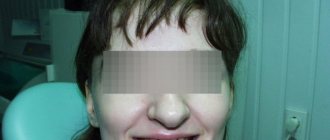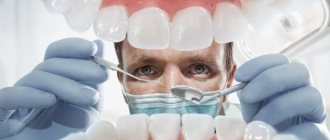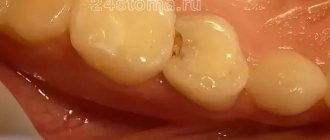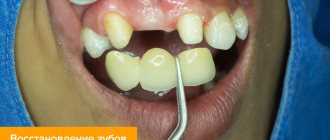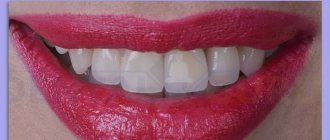Date of publication: 09/18/2013
None of us wants to grow old too early: we use creams to smooth out wrinkles, try to lead a healthy lifestyle, visit cosmetologists and plastic surgeons. Has anyone ever thought that missing teeth leads to the appearance of a huge number of wrinkles on the face? It’s not in vain that doctors recommend taking care of the issue of recovery immediately after tooth extraction: a lot of problems arise - from disruption of the beauty of a smile to serious problems with the body.
Missing teeth and quality of life
If a person is missing front teeth, this will of course distort their natural smile. Such people are perceived by society as inferior and dysfunctional. In addition to the social problem, there is also a medical one: any unit of the dentition is a support for the rest.
The loss of at least one tooth is fraught with a displacement of the entire row towards the removed unit; this is necessary for a more even distribution of the load when chewing. The consequence of this abnormal process is gingivitis (inflammation of the gums), a change in bite.
Modern advances in the field of dentistry make it possible to create dentures and implants that are visually virtually indistinguishable from natural units.
The situation with the loss of chewing teeth is even more complicated: they are “responsible” for grinding, and, therefore, the subsequent processing of food. Over time, this leads to significant digestive problems.
Timely installed crowns, inlays, and veneers can save the damaged tooth. If you lose 3-4 teeth, you will need to install fixed dentures. Such structures last for quite a long time and look almost like natural teeth.
Important! The beginning of the destruction of at least one tooth requires urgent therapeutic measures.
To private owners or to a state clinic?
– What was the minimum score required this year to enter medical school?
– The situation with COVID-19 has determined a fairly high demand for all medical specialties. This year, a record number of applications from applicants were submitted - up to 120 per place for medical treatment. And the passing score for the budget turned out to be unexpectedly high - 278 for three exams. That is, in each of the subjects it was necessary to get more than 90 points! I attribute this to the fact that during this period people began to treat doctors differently.
– Several years ago you insisted that budget places for dentists should be reduced. Has your position changed?
- No. There remains a surplus of dentists. There are five faculties that train dentists in Moscow. This and next year, as part of the distribution of admission target numbers in the Moscow region, budget places in dentistry have been reduced. Of course, we cannot prohibit those who want to study for a fee.
– Why do patients mostly get their teeth treated by private providers, and don’t trust state clinics?
– I can’t agree. Dentistry is included in the state guarantee program. That is, if a person wants to get a filling for free, this can be done in a district or city clinic. Referring to the fact that they will install the cheapest filling there is idle talk. Today, city clinics, and even more so federal centers and clinics, purchase modern materials. And good doctors work there. Private dentistry knows how to properly sell its services. And when asked who to treat your teeth with, I always answer: you need to find your doctor. It doesn't matter where he works. When the patient trusts the doctor, the result will naturally be much better. Good practical experience comes after 5–10 years.
I can assure you as the rector of a specialized university: we have many gifted guys who work at a very good level, sometimes better than in the West. After all, our dentists have university education. In the West, teeth are treated by dentists who do not have higher education.
Treat without a drill. What procedures have dentists refused? More details
How are problems solved?
List of dental diseases
Until recently, this method of helping people who, for one reason or another, were left without natural teeth, was associated with a whole list of contraindications, side effects and other restrictions. Fortunately, today implantation has become more accessible and effective.
The main condition that guarantees the success of the operation is the presence of bone of the required thickness and density. It is these indicators that are responsible for both the endurance of the implant and the functional load that will be placed on the bone.
Life without teeth is a thing of the past. In the modern world, if the patient has no contraindications to implantation and strictly follows the rules of oral care, the artificial dentition “takes root” almost perfectly.
The loss of at least one tooth results in a lot of problems for a person: displacement of other units towards the empty socket, impaired chewing functions, inflammatory processes in the oral cavity
Expert opinion
Roman Borisovich Alekperov
orthopedic dentist
Experience: 24 years
The removal of a tooth is a reason to immediately think about its restoration. Ideally, you should think about this even on the eve of removal. So, for example, in some cases, the doctor can offer you the safest, painless and bloodless implantation - when an artificial root is implanted into a fresh socket of a just extracted tooth. Next, a crown is placed on it, and you get a full-fledged new tooth instead of the extracted one.
The essence of implantation
With innovative developments in the field of implantology, the question of whether it is possible to live without teeth automatically disappears. So, at the first appointment, the doctor asks the patient whether he has any contraindications to surgical treatment (the list of these includes, first of all, diabetes mellitus, hypertension, and chronic blood diseases).
Next, the patient is sent for an X-ray, a computer image of the jaw is taken, the thickness and density of bone tissue is measured, and an implant of a suitable shape and size is selected. The doctor installs a screw in the bone, the gum is sutured or covered with a crown; this work takes the specialist no more than 20 minutes. All manipulations are carried out under local anesthesia, its effect ends 10–12 hours after the operation (the patient may experience pain in the corresponding area).
University
DOSSIER 'KP'
Naumovich Semyon Antonovich, Doctor of Medical Sciences, Professor. 1990-1994 – Deputy Dean of the Faculty of Dentistry. In October 1991, he was elected to the position of associate professor, from 1993 to the present time he has been the head of the department of orthopedic dentistry of BSMU. Author of more than 500 scientific papers, including 9 co-authored monographs, 12 patents.
— Semyon Antonovich, is it true that Belarusians have bad yellow teeth because of chlorine water from the tap?
— Teeth are primarily heredity, genes, even how the fetus developed in the womb is important. But after birth, nutrition and lifestyle come to the fore. Health depends primarily on yourself, and only 11-12% on medicine. Environment, nutrition, lifestyle - these are the three pillars on which health rests.
In addition, dental health can be improved. The republican prevention program contains the main idea - the use of fluoride preparations, it strengthens the enamel. To strengthen teeth, fluoridated table salt is produced in Mozyr.
From 2003 to 2008, I was the chief dentist of Belarus, the main thing is that we did not destroy what was accumulated during the Soviet era: even now in kindergartens and schools, children are examined by dentists, preventive measures are carried out, they are taught oral hygiene, and, if necessary, treatment. If it weren’t for this, our dental health indicators - the KPU index: caries-filling-extracted tooth - would be much worse. Today we are leaders in the post-Soviet space.
There are WHO requirements for each age regarding the number of remaining teeth. Let's take the indicative age category of 65-74 years: the latest European requirements for this age are 20 teeth. But our indicator is quite high: in 2013-2014, Belarusians of this age had up to 15 teeth.
- Is it true that Americans have good white teeth because they eat and drink everything with ice?
— No, rather because a small filling there costs about 100 dollars. The patient is motivated to get a filling, because the next stage is a crown for $600. And if you engage in prevention from a young age, you may not have to pay.
A lot depends on the person himself: how he takes care of his oral cavity, whether he brushes his teeth correctly, chooses a brush and paste. Universal advice - which is better? - no: each has its own characteristics, it all depends on the condition of the mucous membrane and enamel.
“It happens that young people remove 15-20 teeth”
— I heard that every tooth pulled out brings a person closer to old age: they say, the brain receives a signal and rearranges its work...
— The absence of even one tooth is of great importance, especially if it is a front one. But the absence of the so-called “six” is also a problem. If the defect is not closed, the neighboring teeth begin to move, and this is due, as you say, to signals from above. Teeth can move vertically, transversely, or in any other direction - along the line of least resistance. They can also shift at an angle of 5-7 degrees. As a preventative measure, we recommend making a temporary prosthesis – popularly called “butterflies” – to close the defect so that the teeth do not move. And then decide: to make an implant or a bridge based on nearby teeth.
— But the absence of one tooth is not an indication for intervention, or would you still not advise leaving even one hole?
— I wouldn’t recommend it, especially the sixth teeth. As a rule, they are the first of the permanent teeth to appear and the first to wear out; the load on them is colossal. When they are removed, people sometimes do not pay attention and live without a tooth. And after 10 years they come to us with complaints: “Doctor, the muscles on my face hurt.” If a person has lost key teeth, deformation of the dentition begins, and the temporomandibular joints become sensitive. The absence of even one tooth will manifest itself as unpleasant symptoms within 4-7 years.
— Some people are afraid to insert implants - it’s an operation! – especially now, when the number of cancer diseases is growing. And it’s scary to put on “crowns” - they say the teeth under them rot and collapse...
— If the supporting crowns are made with high quality, there will be no damage for 8-10 years. Yes, if the crowns are made poorly - we call them “pans” - a “greenhouse effect” develops under them: food and saliva get in, which leads to tooth decay.
Implants can be installed if the patient has sufficient bone tissue, the bone structure allows for manipulation and there are no contraindications. These include diabetes mellitus, thyroid diseases, and cancer.
Another contraindication is severe forms of periodontal disease, previously called periodontal disease. This is the exposure of the gingival margin, loss of bone tissue, loose teeth, which we most often remove. With such a disease, the implantologist will also refuse you: your own tooth does not take root, how will someone else’s tooth take root? Periodontal disease - when the bone is lost, but the tooth is intact, but must be removed - this is scary. Here, first of all, professional hygiene is important: removal of dental plaque and anti-inflammatory therapy of the gingival margin. Removing visible tartar is easy, but there are also stones under the gum. Sometimes it’s so far away that you can’t take a picture right away. Then they perform a patchwork operation: they peel off the gingival margin and this is the only way to remove the stone. Otherwise, it will mechanically destroy first the gum and then the bone.
The first signs of such a problem are bleeding gums, both while brushing your teeth and without. Plus visible changes: swollen gingival margin with a bluish tint. To recognize the problem at an early stage, every self-respecting person should go to the dentist twice a year.
- But they say that exposure of the roots of the teeth is an age-related feature, no?
— Yes, but often there is also a general pathology, for example, diabetes, blood diseases, and thyroid diseases. Young people with such diagnoses come to us at both 25 and 27 years old. I write the conclusion: “Remove 15-20 teeth.” And even more! There are teeth, but there is no bone tissue where they would be fixed. The teeth move even from a “gust of wind.” As a rule, we provide prosthetics for such patients only with removable dentures.
“If a dentist enters the profession with a counter in his eyes, he will not make a good specialist.”
“But even in such situations, when all the teeth have been removed, there is no need to panic. Yes, you need to get used to removable dentures, but life goes on. Let me give you the example of my grandmother: she had full dentures made in 1933, she was only 35 years old. As a result, she lived happily for 97 and a half years, 60 of them with complete dentures. When I offered to make her new ones, she just waved her hand: “They don’t make them like that now...” But I still reconstructed them several times, since such prostheses must be remade every 5-6 years. And as a specialist, I understand well that she would never have lived this long without them...
— I have a friend who, before leaving for America about 10 years ago, made himself new teeth: he pulled out his own and inserted beautiful, white implants. Two years later, the first thing that caught my eye was how his face had changed, how it was swollen or something. He complained: his joints hurt and it was difficult to eat. Is this poor-quality work or is it rather the body’s fault that it rejects something foreign?
- More likely, both. Unfortunately, this happens. The first attempts to make implants began in Minsk at the 13th dental clinic back in 1989. I then worked as deputy dean of our dental faculty, I was appointed chairman of the commission for evaluating those first experiments. The methods were rather weak, but our specialists were trained in Vilnius. The first steps were with problems, today I understand that those implants were not installed very well...
But 26 years have passed, and today there are practically no such problems, we are among the world statistics: implants serve the patient for 9-12 years or more. Yes, it happens that patients come to us - they were promised a lot, implants were installed, then crowns were made on them, people paid a lot of money - and after a year we remove and remove everything. It happens that prosthetics are carried out with numerous errors: in the upper jaw, for example, the implant is removed into the maxillary sinus, in the lower jaw - into the mandibular canal, inflammatory processes begin. But, thank God, such cases are rare.
The best school graduates come to our dental faculty, over the last 10-15 years - with a score from 370 to 400. Previously, the medical faculty was the best, now we have practically no competitors. We train general dentists who, after graduating from university, not only have good theoretical knowledge, but also have excellent practical skills in all areas of dentistry.
— It’s logical, I heard that dentistry is the easiest way to earn good money in medicine, the main thing is to open your own private office.
— Unfortunately, I also hear about this often. But this is not such an easy bread, it is associated with occupational hazards and great psychological and physical stress. If a person enters a profession with a calculator in his eyes, he will not make a good specialist...
“We once reduced the size of the lower jaw.”
“I would never have thought that a beautiful smile can be achieved with the help of braces: a person hasn’t smiled for half his life because of ugly, uneven teeth, and then one day he starts to shine!”
— I have been dealing with this problem for almost 40 years. When I started working in the late 70s, there was only one orthodontist in the entire Minsk region. At the regional dental clinic, he saw 80 patients in 6 hours of work: 40 patients had impressions taken, 40 had ready-made orthodontic plates applied. There were no braces yet, only removable devices.
Nowadays, with the help of braces, you can manipulate your teeth and dentition quite widely: move, reduce, expand. But braces can be used when the bite is formed: no earlier than 11-13 years.
In complex cases, an integrated approach to the treatment of such patients is needed. First, they undergo preparatory surgical operations. So, for a student from Syria - his chin protruded four centimeters forward - my teacher, Professor Chudakov, and I reduced the size of the lower jaw. And only then they installed orthodontic devices, straightened the remaining teeth and completed the treatment with dentures.
—What incident impressed you the most?
“Once a LAZ driver came to me; there were buses like this that were produced in Lvov. The rotating iron handle of the starter crushed half of his face, knocking out almost all his teeth, along with the alveolar processes (the part of the jaw where teeth grow from). My teacher, Professor Velichko, and I restored his jaws and made luxurious ceramic removable dentures. Later, years later, he came and thanked them for helping him improve his life: he got married and looked great.
I also remember when I was just starting to work, a young man approached me and asked me to do his wife’s teeth. They looked and gasped: she had 28 rotten roots and not a single tooth. And she is only 25 years old! We had to remove all the remains, it was impossible to restore them, and make removable ceramic dentures. In those days, no one did implants in our country. It turned out that my husband didn’t even know what was in her mouth, and we didn’t tell him either. She was a nice girl, I remember, I also advised her: “You know, don’t take them off at night - just for hygiene - don’t let her know anymore...”
Photo: DMITRY LASKO Komsomolskaya Pravda , February 9, 2016
Affordable Alternative
Life without natural teeth is associated with a lot of physical and moral inconvenience. Such people cannot eat properly, they have social problems, and their speech is impaired. Implantation is not the only way out of this situation. Often, if individual teeth are not very “neglected,” you can get by with traditional prosthetics.
Firstly, it is less painful, takes longer and is safer, and secondly, it is much cheaper. Unfortunately, most modern patients believe that they cannot live without implantation, and even with the slightest dental problems they are sent to see an implantologist.
Some unscrupulous specialists simply profit from such people, extract teeth that could have been treated and replace them with expensive implants. As we can see, innovative achievements in dentistry provide patients with a fairly wide choice of techniques that make it possible to compensate for tooth deficiency.
A toothless smile has long become a relic of the past, because with the help of prosthetics and implantation it is possible to regain dental units lost for various reasons. The only drawback of such technologies is their high cost, but nevertheless, most people are willing to pay a lot of money for the health and aesthetics of their teeth.
Causes of edentia
The first cause of adentia is periodontitis.
The second cause of edentia is caries.
The third reason for tooth loss is pulpitis
The fourth cause of adentia is periodontitis.
The fifth possible cause of adentia is hypoplasia
The most common thing is the lack of proper oral hygiene and care.
There are three diseases that provoke tooth loss - periodontitis (soft tissue diseases), caries and its complications (pulpitis and periodontitis) and hypoplasia (underdevelopment of tooth tissue, most often enamel).
There are other reasons for tooth loss - due to a blow or some complex disease - but such cases are exceptions to general practice, so we will not dwell on them in detail.
The main reason leading to tooth loss is, after all, a lack of proper attention to one’s health and letting the first signs of illness take their course.
There is no consensus or single way to prevent caries or periodontitis; the occurrence of these diseases can be influenced by various factors - genetic predisposition, poor nutrition, poor hygiene and even the area of residence. But timely diagnosis and proper treatment always save the patient from many further health problems.
Alena, 25 years old
I used drugs for 6 years. Osteomyelitis began 4 years ago. I then removed the tooth and an abscess began. I took antibiotics and everything seemed to be fine. Then - again an exacerbation. Doctors say we need money for an operation.
The attitude is quite negligent. The last time they picked me up in an ambulance, and in the morning they sent me home: there was no insurance, there was nothing to pay.
Now it’s hard for me to eat and swallow. I hardly look in the mirror - it’s very scary. If I had known what would happen to me, I probably wouldn’t even have taken drugs. I dream of returning to my previous appearance, so that everything will be as before.
I no longer use Vint, but I indulge in other drugs. I can't quit completely.
I would advise those who are on the “screw” to quit, since in this case no one is safe from osteomyelitis. In general, it’s better not to try anything, not to get burned, not to step on the same rake that someone has already gone through.
